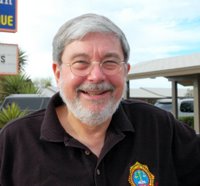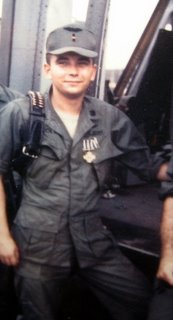



I took a long southern campaign trip this week and had breakfast with Jack Swickard in Roswell. Jack was an Albuquerque Tribune Reporter, Editor of the Farmington Daily Times and Editor of the Roswell Daily Record. I got to know Jack through my brother Tom Baca. These two photos are of these guys as the look today.
These photos are from 1967 in Vietnam where Jack and Tom served as helicopter pilots. They still look pretty good.
Jack and Tom recieved the Distinguished Flying Cross for their valor on one mission. That mission is described in Jack's narrative below.
As the aircraft commander of a UH-1D “Huey” helicopter in the First Flight Platoon of the 118th Assault Helicopter Company stationed at Bien Hoa Air Base, South Vietnam, I was assigned to fly a U.S. Special Forces paymaster from camp to camp on May 14, 1967. On the morning of the mission, Lt. Al Croteau, who commanded the 198th Signal Detachment, which was attached to the 118th Assault Helicopter Company, asked me what type of flying I would he doing that day. When I told him that it would be flying the Special Forces paymaster from one camp to another, he asked if he could fly in place of the door gunner on the crew.
Lt. Croteau indicated he was attempting to gather enough hours of flight time to earn an Air Medal, and was looking for a mission in which he could log some hours of direct combat support time.
After picking up the Special Forces paymaster, we flew to an outpost called Cau Song Be, near Tay Ninh City. I landed on a dirt strip outside the compound. As I was starting to shut down the engine, one of the crewmembers on my helicopter told me that another UH-1 “Huey” had landed on the strip behind me.
I saw a Special Forces major running toward my aircraft, waving his hands. He ran up to my door and told me a company of South Vietnamese soldiers and their U.S. Special Forces advisers had been surrounded by a large force of Viet Cong and North Vietnamese troops about five kilometers west of the compound. The major asked if I could fly in and airlift them back to the compound. He said the group had taken some casualties and was under attack.
He told me: “You don’t have to go in, but we sure would appreciate it if you could get them out of there.”
When I told him I would try to fly the South Vietnamese and their advisers out, he said he would contact the pilot in a Huey behind mine about joining the rescue attempt. I sent my crew chief to the other aircraft with a note on which I had written an FM radio frequency over which we could communicate.
I learned the aircraft commander of the other helicopter was Warrant Officer Tom Baca, assigned to flying VIP missions for II Field Forces Victor. He had landed at Cau Song Be to drop off a chaplain.
I told him I would lead the flight of two aircraft on the rescue attempt because my Huey had two .30-caliber machine guns, which his did not.
The Special Forces major returned and told me that he had requested an air strike by the Air Force prior to the rescue, and had asked for helicopter gunships to accompany us. WO Baca and I tuned our radios to the Air Force forward air controller’s frequency and took off from the strip. Baca was flying in trail formation behind me as we climbed to about 2,500 feet and circled the area. The forward air controller called the senior U.S. adviser and asked him to pop a smoke grenade to identify his position before the air strike. I saw about eight smoke grenades pop about the same time.
The PAC told the adviser about the number of smoke grenades and then asked him what color he had popped. He said green. However, there were two green grenades. The adviser said his was near a road. I saw that another smoke grenade had popped within 30 feet of the green grenade set off by the adviser. The FAC told the adviser the enemy was too close to the South Vietnamese to call in an air strike. He then sent the Air Force jets back to their base.
We were joined by two UH-1C helicopter gunships, whose team leader told me the two planes were running low on fuel. I flew east of the area where the South Vietnamese and their advisers were located, back to the compound at Cau Song Be, and descended to tree top level. Flying at about 90 knots, I lowered the fuselage of the Huey below the level of the trees and bamboo growing along both sides of a narrow road that led from the compound to where the South Vietnamese had been ambushed. Only the rotor and the top part of the rotor mast were above the vegetation.
When I figured I was near the South Vietnamese company, I told the senior adviser to pop a smoke grenade so that I wouldn’t overshoot his position. Within seconds I saw smoke drifting ahead of me. I flared the Huey over the smoke and leveled the aircraft above bamboo growing along the side of the road. We were hovering high over the troops and there didn’t appear to be any clearings nearby, so I chopped my way to the ground with the rotor blades.
Immediately after the Huey touched down, the South Vietnamese started climbing aboard the Huey through the open cargo doors. I could hear shots being fired at my aircraft and some of the South Vietnamese were hit by rounds while on board the Huey.
I looked out of the cockpit to see where the shots were coming from, but the bamboo and trees were too dense to see more than 15 or 20 feet. The South Vietnamese defense perimeter was within the sweep of my rotor blades.
I can remember Lt. Croteau asking me how to operate the M60 machine gun. I told him not to fire it, that he would probably hit some friendlies. He then asked me what he should do. I asked him if he had brought a camera along. When he said “yes,” I told him to shoot some pictures so that we would have a souvenir. I looked back and he had taken out his camera and was shooting pictures of dead South Vietnamese soldiers alongside the Huey.
After 10 of the wounded South Vietnamese soldiers were aboard the aircraft, and WO Baca said he had a full load of wounded, I hovered the aircraft straight up through the hole I had chopped through the bamboo.
When the rotors were above the top of the bamboo I was starting to lose engine rpm from hovering so high with a heavy load. I was able to pick up speed gradually, again flying with the Huey’s fuselage below the level of the vegetation and over the road. After flying low level for several kilometers west of the ambush, I lifted the nose of the Huey and climbed to 1,500 feet.
Baca and I flew the South Vietnamese back to the compound at Cau Song Be, dropped them off and returned to the ambush site, again flying low level above the road. The two gunships rejoined us as we started back toward the ambush site.
Again, I asked the U.S. adviser to pop a smoke grenade when he heard us approaching. I found the same holes in the bamboo we had cut earlier, and lowered the aircraft back to the ground. There were more dead South Vietnamese in the landing zone (LZ) and I could hear more small arms fire. More wounded were placed aboard the Huey. When the load reached 10 soldiers and Baca said his aircraft was loaded, we hovered back to the top of the bamboo and flew low level out of the area. As we exited, the gunship team leader radioed that his aircraft were low on fuel and had leave the mission.
Baca and I flew the wounded back to Cau Song Be, and made a third trip to the ambush site to pick up the South Vietnamese and their U.S. advisers. This time, some of the South Vietnamese soldiers were killed by gunfire after they had climbed aboard the aircraft. I can recall looking back and watching the U.S. adviser throw their bodies off the Huey.
Baca and I flew our aircraft back to the landing zone, without gunship cover, a fourth and a fifth time. We were able to rescue all of the South Vietnamese soldiers and the U.S. advisers who were still alive. We left the dead in the landing zone. In all, the two helicopters carried about 120 people out of the ambush. No helicopter crewmembers were wounded.




3 comments:
Hi Jim. I just saw a documentary over here in Oxford, UK about Tom et al and that amazing mission in 67 where they were all awarded the DFC. I can't even begin to put into words how touched I am by their bravey.
Dr Tim O'Neill
I had the pleasure of meeting Jack Swickard and Tom Baca while I was attending New Mexico Military Institute. Humble men, and true American Heroes!
I am touched and amazed at the bravery and heroism of Jack Swickard and Tom Baca. My maiden name is Swickard and coincendentally, my father, John H. Swickard, 1930-2016, also was stationed in New Mexico at the White Sands Missile Base during the last year of the Korean Conflict and was a photographer for the army. Thank you so very much, Jack and Tom and all who have served our great country!!!
Krista L. Williams (nee Swickard)
Post a Comment